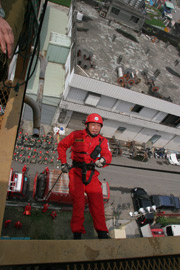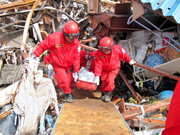BY TAKIO MURAKAMI CORRESPONDENT
2011/07/05

A member of the International Headquarters Search and Rescue, Taiwan, descends a building with a rope in Taiwan as applicants look on from the ground. (Takio Murakami)

Members of the International Headquarters Search and Rescue, Taiwan, carry a victim's body in Iwate Prefecture on March 16. (Provided by International Headquarters Search and Rescue, Taiwan)
TAIPEI--From all walks of life they come, Taiwan's bravest and toughest, the men and women volunteers who risk their lives in disaster zones, sporting the national flag on their red uniforms.
Up to 3,700 citizens, from company owners and public servants to researchers and students, are on standby for the International Headquarters Search and Rescue, Taiwan (Taiwan Rescue).
In late May, 36 applicants took part in a rigorous two-day training session at Taiwan Rescue headquarters in Taoyuan County, northern Taiwan.
Most were young men, but there were a few women and middle-aged men.
Would-be rescue workers, supported by a rope, descended from the sixth floor, first face down and then face up.
"Look at the mountains far away, not the ground," a supervisor said. "Get off."
During a lunch break, Commandant Lu Cheng-tsung, a 56-year-old former member of the military's special force, told the applicants: "The real difficulties that need to be overcome are in your own mind."
About half the applicants usually drop out halfway through the training, which involves such exercises as camping in the mountains and forgoing a bath.
Taiwan Rescue has its roots in a group of volunteers who rescue people stranded in mountains, which Lu set up in 1981 with friends after saving a couple.
The group expanded its scope of activities as it dealt with natural disasters, such as earthquakes and floods.
Taiwan Rescue can quickly respond to a disaster, with vice commanders mobilizing squads responsible for each region.
It owns rescue vehicles and equipment, such as systems to detect survivors by their body heat or sound. Its headquarters is equipped with a 6-meter-deep tank for underwater training and a rock climbing wall.
Even Taiwan's military has asked the nongovernmental organization to provide training because their disaster response capabilities exceed those of firefighters and police officials.
Volunteers undergo training once every three months after they are enrolled.
In one session, they must catch a snake in a pitch-dark room because poisonous snakes are found in the mountains.
Li Wei-hao, 24, a postgraduate student of resource engineering in Taipei, recalled that he was initially frightened by the grueling training regime.
Li transported supplies as part of a different volunteer group after a typhoon hit central and southern Taiwan in August 2009. He felt he had wanted to do more than just logistical support.
Li happened to meet Taiwan Rescue members on the train on his way back, was impressed by one member's experiences and joined the group in autumn the same year.
"I make it a rule to finish an assignment from my professor on the day it is given because I may be called at any time," he said.
While only 23 countries maintain diplomatic relations with Taiwan, Taiwan Rescue has been active in overseas disaster zones.
After the Great East Japan Earthquake struck on March 11, Lu led a team of 35 members in Ofunato, Iwate Prefecture, for four days from March 15.
The rescue workers recovered victims' bodies along with firefighters and handed them to police. They also donated rescue equipment.
Taiwan separately sent its official team of 28 rescue workers, including firefighters.
Lu could have found himself in a diplomatic squabble when he came across a Chinese relief team in Ofunato.
"Is this the flag of the Taiwan district?" a Chinese rescue worker asked, pointing to the flag on the breast of his uniform.
Lu replied immediately and firmly, "This is the national flag of the Republic of China."
No confrontation ensued.
Taiwan Rescue also sent rescue workers after a magnitude 7.0 earthquake in Haiti in 2010, a magnitude 9.1 earthquake off Sumatra, Indonesia, in 2004 and a magnitude 7.6 earthquake in El Salvador in 2001.
Members were also mobilized to rescue victims of a flood in Myanmar (Burma) in 2008 and a mudslide in the Philippines in 2006.
With its official activities limited abroad, Taiwan can emphasize the group's track record as its contribution to the international community.
Lu's group was not able to dispatch members when a magnitude 8.0 earthquake rocked China's Sichuan province in May 2008.
The group offered to assist immediately after the disaster, but Chinese officials only thanked them for the offer.
In many ways, the group symbolizes the dynamism of Taiwanese society.
Its activities are funded by donations from domestic and foreign companies and charitable organizations as well as membership fees from supporters.
It also receives close cooperation from a Buddhist organization with a strong fund-raising capability.
The group became known for its activities after a major earthquake hit central Taiwan in 1999.
Lee Teng-hui, Taiwan's president at the time, has backed the group. After members returned from Japan in March, Lee organized a party to recognize and honor their service.
While some see the group under the influence of Lee, an advocate of Taiwan's independence, Taiwan Rescue maintains political neutrality. |


